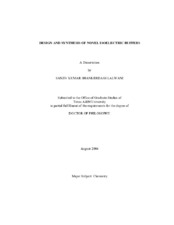| dc.description.abstract | Hydrolytically stable, low- and high-pI isoelectric hydrogel membranes were
prepared from poly(vinyl alcohol) (PVA) as alternatives to polyacrylamide-based
isoelectric membranes that hydrolyze in acidic and basic solutions.
Low-pI membranes were made by attaching an isoelectric buffer of a welldefined
pI value (such as iminodiacetic acid, IDA, aspartic acid, ASP or glutamic acid,
GLU) to the PVA backbone and crosslinking the PVA strands, in situ. The pH in these
membranes does not change significantly with slight variations in the amount of
isoelectric buffer that gets incorporated. The pI values of these membranes were pI is greater then 1.7 but less then 2.0 (IDAPVA), pI is greater then 2.0 but less then 2.6 (ASPPVA) and pI was greater then 2.6 but less then 3.4 (GLUPVA).The membranes were used as anodic membranes in isoelectric trapping (IET) experiments. Sugars, cyclodextrins (CDs), and certain polyhydroxy compounds have pKa
values between 11.5 and 14. Thus, high-pI hydrogels were obtained by incorporating (i)
quaternary ammonium derivatives of Beta-CD (QCDPVA) (ii) quaternary ammonium groups and Beta-CD (CDQPVA) and (iii) quaternary ammonium groups alone (QPVA) into the crosslinked PVA hydrogels. All three membranes had pI values greater than 11 and
served as effective cathodic membranes for the IET of small ampholytic molecules and
proteins. In pH-biased IET, proteins are collected into solutions of isoelectric buffers that set the pH to keep the proteins in a charged state affording high solubility and preventing precipitation. Thus, a series of isoelectric buffers (biasers) with high buffering capacity, high conductivity, and pI values covering the useful pH 2-10 range are needed.
Two sets of such buffers were designed (i) with pI values between the pKa values of two carboxylic acid groups and (ii) with pI values between the pKa values of the conjugate acid form of two amine groups. Six of these buffers were synthesized and their synthesis was optimized. The products were obtained in their pure, isoelectric form and were extensively characterized. | en |


